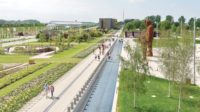In this thoughtful and concise new book, William Fain answers the question in his title by anticipating that his car, given the opportunity, would ask, “Why do you make such a fuss over me? Why do people spend so much of their resources on me? Why do architects and city planners give such high priority to me in their designs for neighborhoods and downtowns?”

Using his home city Los Angeles as an example in a series of linked essays, Fain describes how the car—having dominated past urban development decisions—reigns supreme.
With apt and wittily selected illustrations by California-influenced artists such as David Hockney, Edward Ruscha, and Wayne Theibaud, he illustrates the often negative social, economic, environmental, and placemaking implications of the freeway and its accompanying mall culture.
In exploring these historical implications, Fain (a principal in the Los Angeles-based architecture and urban design firm Johnson Fain) draws on his prolific career as a practitioner and teacher. He backs his writing with analysis of the last 40 years of urban thinking, ranging from the public policy proposals of Jonathan Barnett (with whom he worked in the 1970s at New York City’s Urban Design Group), to the permissive, open-ended planning theories of Melvin Webber and the bottom-up pattern language of Christopher Alexander. He punctuates this framework with critiques from contemporary commentators such as Michael Sorkin, Richard Sennett, and Robert Campbell.
Creatively integrating his insights into a series of introductory guiding principles, Fain applies them throughout the book to the urban design issues raised by California’s unrelenting auto-centricity. He describes the need to create dense, transit-oriented but pedestrian-friendly, mixed-use centers as an antidote to single-use parking-based nodes like Los Angeles’ Century City. He praises the context-sensitive urban design of Raymond Hood’s Rockefeller Center in comparison to the frightening bulk of Rem Koolhaas’ CCTV megastructure in Beijing. And he proselytizes for “complete streets”—boulevards (rather than freeways) that support a variety of transportation modes and walkable adjacent uses.
But ultimately Fain’s response to his car’s questions—the reasons for its continuing ubiquity—is incomplete, and still vexing to the urban designer. For the last 100 years, the car has represented freedom and infinite possibility. Its rapid acceptance led to a national land-use and development framework built around its low-density, decentralizing implications.
For this reason, the car’s existential musings cannot lead to a “to-be-or-not-to-be” (and therefore “either/or”) proposition. Rather, for the urban designer in the 21st century, the answer must be to define “both.”
On the one hand, the challenge is to retrofit—to superimpose onto environments like Los Angeles an alternative infrastructure of transit-rich connectors and mixed-use centers, built to a density that will in turn support public investment in transportation and public-realm design.
But on the other hand, we need to come to terms with the reality and valid purpose of the car as the only viable means of transportation for our nation’s existing, omnipresent matrix of small towns and low-density suburban development.
Promising changes in the car itself may point the way to solutions for both problems. The potential for smaller, more carbon-efficient vehicles, coupled with the rise of car-sharing systems that integrate with other transit modes, offer opportunities to transform both urban and suburban places.
After reading Fain’s open-ended book, we can anticipate that his car, rather than questioning the meaning of its existence, will look forward to its own evolution, from a dominant dictator of urban form to a partner in a new and integrated landscape of mixed densities, multiple travel modes, and livable communities.



